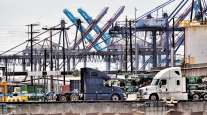Ports Post Strong Volume for 2022 Despite December Drop-Off

[Stay on top of transportation news: Get TTNews in your inbox.]
Despite a significant slowdown in the second half of 2022, two major West Coast ports approached the record-setting pace they had in 2021.
Port of Los Angeles officials said the facility still finished as the nation’s busiest container port for the 23rd consecutive year, processing 9,911,158 20-foot-equivalent units, down nearly 7.2% from 2021’s 10,677,609.
For December the port processed 728,871 containers, down 7.3% to 786,588 year-over-year.
“We started 2022 at that same frenetic pace with 109 vessels in our queue, yet we ended with a disappointing 20% decline that began last August,” Executive Director Gene Seroka said during his annual State of the Port address. “That was triggered by an early peak season, the shifting of cargo to the East and Gulf coasts, and now more recently, a nationwide slowing of imports. Still, even with all that, nearly 10 million container units crossed our docks, making 2022 our silver medal year — the second best in our 115-year history.”
ICYMI: In his 2023 State of the Port address, Port of Los Angeles Executive Director Gene Seroka shares how the #PortofLA has become a stronger, more resilient port.
More speech highlights here: https://t.co/aQirSXDtw1 — Port of Los Angeles (@PortofLA) January 25, 2023
The adjacent Port of Long Beach also saw a significant slowdown in volume in December, plunging nearly 28% to 544,104 containers from 754,314 a year earlier.
Even with the drop-off, Long Beach marked its second-busiest year on record by moving 9.13 million last year, down 2.7% from 2021, its most active year in its 112-year history.
Combined, the facilities processed more than 19.4 million containers in 2022, far exceeding any port complex in North America.
The Port of Oakland saw a 3.8% decline in December, moving 163,208 containers, compared with 169,660 in 2021.
TEUs for 2022 were 2.3 million, marking a 4% decrease from 2021’s 2.4 million.
Port of Oakland congestion eases as overall container traffic continues to decline. Container traffic for 2022 declines by 4%, with 2.3 million TEU’s transiting the @Port of Oakland. https://t.co/blVvjRjT2h #port #oakland #portofoakland #containerport — Port of Oakland (@PortofOakland) January 17, 2023
“The variation in cargo volumes and the relocation of containers is to be expected as the economy emerges from the COVID-19 pandemic,” Port of Oakland Maritime Director Bryan Brandes said. “The return of empty containers to Asia is a positive step to avoid future port congestion.”

The Northwest Seaport Alliance, consisting of the ports of Seattle and Tacoma, Wash., reported an 8.7% decline in cargo in December, processing 231,799 containers compared with 254,102 in the same period a year ago. The ports were down 9.4% to 3,384,018 from 3,736,206 for all of 2022.
However, while container volume fell, automobile volume increased 5.6% because of logistics consultant Glovis America’s consolidation of its Kia and Hyundai automobiles to those ports.
Port Houston in 2022 broke its all-time volume record, even with a 12.1% year-over-year decline. The facility processed 292,027 containers in December compared with 332,313 in the year-earlier period. For the year, Port Houston handled 3,974,601 TEUs versus 3,482,375 in 2021.
#TriviaThursday. Steel import tonnage reached its highest numbers at Port Houston in 2022 in the last five years. When was the last time Port Houston had record steel import tonnage? #PortHOU #Facts pic.twitter.com/ZeoMh9lJWJ — Port Houston (@Port_Houston) January 19, 2023
The port also reported record volumes for steel product shipments related to the energy sector. Those were up 49% for the year. Auto import units ended 2022 up 7%, and bagged goods imports were up 50% year-over-year.

Wooten
On the Atlantic Coast, Georgia’s Port of Savannah had its second-slowest month of 2022 in December, moving 440,759 TEUs compared with 464,951 a year earlier. Still, the port shattered its 2021 record for container volume; it finished 5% higher when measured against 2021, processing 5,892,131 TEUs, compared with 5,613,163. In less than 10 years, Savannah’s growth has doubled from 2.9 million TEUs in 2012 to nearly 6 million last year.
“We’re excited about the possibilities ahead, with major infrastructure projects delivering greater capacity and efficiency for our customers,” Georgia Ports Authority Chairman Joel Wooten said.

Host Seth Clevenger speaks with Waabi's Vivian Sun and Apex.ai's Jan Becker about how autonomous trucks can fit into the freight transportation industry. Hear the program above and at RoadSigns.TTNews.com.
First of a three-part series on autonomous vehicles. Part II coming Jan. 26. Part III coming Feb. 2.
Port officials say projects that are underway will increase the facility’s capacity to 9 million TEUs by 2025.
The Port Authority of New York and New Jersey, which briefly claimed the title as the nation’s busiest port this past summer, likely will move into the No. 2 slot once all the numbers are tallied. That facility usually is weeks behind the other ports in reporting volume. In November, workers processed 3.7% fewer containers, 723,069 compared with 759,392 in 2021. Entering the last month of the year, New York-New Jersey had moved 8.1% more containers than in 2021, 8,880,653 compared with 8,215,178 in 2021.
The Port of Virginia set a container volume record in 2022 by processing 5.1% more TEUs — 3,703,229 compared with 3,522,833 year-over-year. December saw a slight decline to 273,965 from 285,943.
South Carolina Ports Authority reported a record in 2022 as it handled 1.5% more TEUs than the previous year, 2,792,313 compared with 2,751,442. The milestone occurred even as December saw an 11% decline. SCPA moved 219,351 TEUs compared with 246,198 in the same month in 2021.
Want more news? Listen to today's daily briefing below or go here for more info:




